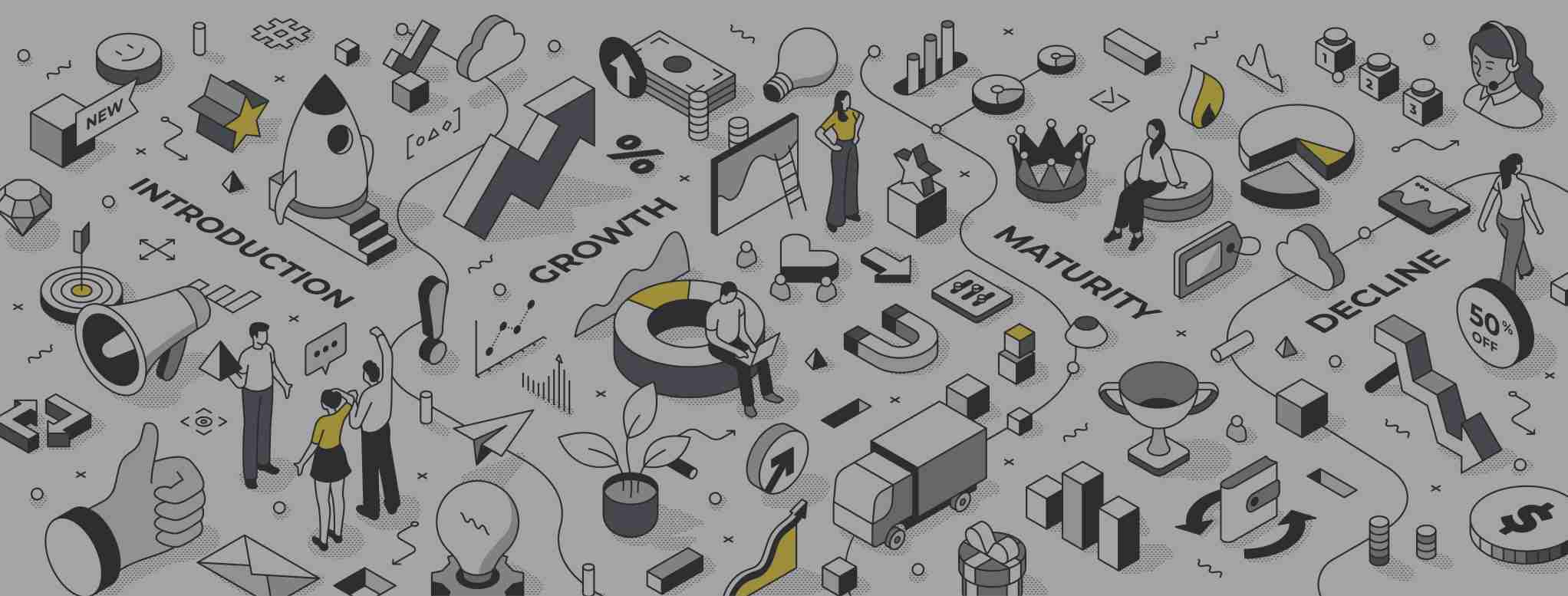At Digital BIAS, our team has over 20 years of experience working with technology and services companies across product, marketing, and sales. This experience, combined with our HubSpot expertise, helped craft the approach. Below, we introduce the JTBD framework, how it works and how it impacts ARISE®.
The ARISE™ GTM framework—Assess, Research, Ideate, Strategise, and Execute—provides a structured approach to bringing products to market. Integrating the Jobs-to-Be-Done (JTBD) framework into each stage of ARISE™ can significantly enhance the effectiveness of your go-to-market (GTM) strategy by ensuring that every step is deeply rooted in understanding and addressing customer needs.
This article will show the advantage of bringing JTBD to our proprietary ARISE® methodology to uncover unique market opportunities. It’s a comprehensive framework that enables B2B technology and service companies to launch new products and services or to optimise their current GTM approach.
What is the Jobs-to-Be-Done (JTBD) Framework?
The Jobs-to-Be-Done (JTBD) framework is a powerful approach to understanding customer needs and motivations by focusing on the "jobs" that customers hire products or services to accomplish. Unlike traditional methods that emphasise product features or customer demographics, JTBD centres on the underlying goals and outcomes that drive customer behaviour. Here’s a detailed look at what the JTBD framework entails:
Core Principles of JTBD
- Customer-Centric Focus: The JTBD framework shifts the focus from the product to the customer's needs and desired outcomes. It asks, "What job is the customer hiring this product to do?" rather than "What features does this product have?"
- Functional, Emotional, and Social Jobs: Jobs are not just functional tasks; they also have emotional and social dimensions. For example, a customer might hire a product to accomplish a task (functional), feel a certain way (emotional), or gain social approval (social).
- Stable Over Time: The jobs customers need to get done remain relatively stable, even as products and technologies change. This stability makes JTBD a reliable focal point for innovation and value creation.
- Solution-Agnostic: JTBD is solution-agnostic, meaning it focuses on the job rather than the specific solution. This perspective opens up new possibilities for innovation by considering various solutions.
How JTBD Works
1. Identifying the Job-to-Be-Done
The first step in applying the JTBD framework is identifying the core job customers are trying to accomplish. This involves understanding the context in which the product is used, the desired outcomes, and the barriers customers face. For example, in Clayton Christensen's famous milkshake case study, the job was not just to enjoy a milkshake but to provide a convenient and satisfying breakfast for commuters.
2. Creating Job Statements
A job statement succinctly describes what the customer is trying to achieve. It typically follows a structure that includes an action verb, the object of the action, and the context. For example, "Find the right music vibe for working out" is a job statement that captures the essence of what a customer might hire a music streaming service to do.
3. Mapping the Job Process
The JTBD framework involves breaking down the job into discrete steps, known as a job map. This map outlines the entire process the customer goes through to get the job done, from start to finish. Each step is analysed to identify pain points, desired outcomes, and opportunities for improvement.
4. Capturing Desired Outcomes
Desired outcome statements are specific metrics that customers use to measure success in getting the job done. These statements are stable, measurable, and controllable, providing clear targets for innovation. For example, a desired outcome for tax preparation software might be "Minimise the time spent on data entry".
How JTBD specifically contributes to each stage of the ARISE™ framework
This section of the article discusses how JTBD impacts each framework stage and why it’s important to understand.
1. Assess
During the first stage of the framework, we undertake a deep dive into the business. We start with a content review, then analyse your website performance, HubSpot portals, and tech stack for friction and costs. We review your personas and assess your documented GTM strategy, team skills, and product and reporting performance.
Objective: Evaluate the current market landscape and understand customer needs.
How JTBD Helps:
- Uncovering True Customer Needs: JTBD focuses on the underlying jobs that customers are trying to accomplish rather than just the features they want. This helps identify the real problems and opportunities in the market.
- Identifying Pain Points and Motivations: By understanding the jobs customers hire products to do, you can pinpoint specific pain points and motivations that drive their purchasing decisions. This insight is crucial for a thorough market assessment.
2. Research
At this stage, we conduct competitive analysis (SWOT, Porter's 5 Forces), customer feedback, win-loss interviews, and reassess the market size.
Objective: Conduct detailed analysis and gather data on customer needs, market trends, and competitive landscape.
How JTBD Helps:
- Structured Customer Interviews: JTBD provides a framework for conducting in-depth customer interviews, focusing on the jobs they need to get done, the desired outcomes, and the barriers they face. This qualitative data is invaluable for comprehensive market research.
- Highlighting Unmet Needs: By focusing on important but underserved jobs, JTBD helps identify gaps in the market where your product can provide unique value.
3. Ideate
As part of the ideation stage, we get creative and data-driven. We address your positioning, messaging, storytelling, and value proposition. Additionally, we bring JTBD into the mix and our own service design workshops to redesign a customer-centric approach to your GTM strategy.
Objective: Generate ideas and develop solutions that address the identified customer jobs.
How JTBD Helps:
- Guiding Product Development: JTBD insights guide the ideation process by highlighting the functional, emotional, and social dimensions of the jobs customers are trying to accomplish. This ensures that the ideas generated are aligned with real customer needs.
- Prioritising Features: Understanding which jobs are most critical to customers helps prioritise features that will deliver the most value, ensuring that the product development efforts are focused and effective.
4. Strategise
During the penultimate stage of ARISE, we examine your goals and objectives, content strategy, personas and segmentation, keyword strategy, website requirements, asset requirements, paid marketing strategy, reporting, Hubspot optimisation, sales enablement, and, of course, leveraging the outcome of your jobs to be done work.
Objective: Develop a strategic plan to bring the product to market.
How JTBD Helps:
- Creating Customer-Centric Strategies: JTBD ensures that the strategic plan is rooted in a deep understanding of customer jobs, leading to more relevant and compelling value propositions.
- Aligning Marketing and Sales: JTBD helps align marketing and sales strategies with customer needs by focusing on the jobs customers are trying to accomplish, ensuring consistent and effective messaging across all channels.
5. Execute
Finally, we execute. At this point, we segment the pipeline, begin content updates and production, optimise or redesign the website, strategically employ and deploy your Hubspot, run your paid ads, deliver your KPIs and associated reporting and run regular quarterly reviews.
Objective: Implement the strategic plan and bring the product to market.
How JTBD Helps:
- Effective Messaging and Positioning: JTBD insights help craft marketing messages that resonate with customers by clearly communicating how the product helps them get their jobs done.
- Optimising Customer Experience: By designing for the entire job, JTBD ensures that the end-to-end customer experience is optimised, increasing satisfaction and loyalty.
- Continuous Feedback and Iteration: JTBD provides a framework for gathering customer feedback and making iterative improvements, ensuring that the product continues to meet evolving customer needs.
Integrating the Jobs-to-Be-Done framework into the ARISE® GTM strategy enhances every stage by ensuring that all efforts are aligned with a deep understanding of customer needs. This customer-centric approach leads to more effective market assessments, targeted research, innovative ideation, strategic planning, and successful execution.
By focusing on the jobs customers are trying to accomplish, businesses can create products and marketing strategies that deliver real value, driving customer satisfaction and business success.
But did you know that there are nine tenets of JBTD? Understanding these can deepen your perception of how and why you employ jobs to be done to enhance your go-to-market strategy.

The Nine Tenets of Jobs-to-Be-Done (JTBD) Theory
The Jobs-to-Be-Done (JTBD) theory, developed by Clayton Christensen and further refined by other thought leaders, provides a robust framework for understanding customer needs and driving innovation. The theory is grounded in nine core tenets that explain how people make purchasing decisions based on the job they are trying to accomplish. Here are the nine tenets of JTBD theory:
1. People Buy Products and Services to Get a “Job” Done
Customers don’t buy products or services for their own sake; they hire them to accomplish a specific job. This job is the progress they try to make in a given circumstance. For example, people don’t buy a drill bit for the bit itself; they buy it to make a hole.
2. Jobs Are Functional with Emotional and Social Components
Every job has functional, emotional, and social dimensions. The functional aspect is the practical task the customer wants to complete. The emotional component relates to how the customer feels about getting the job done, and the social dimension involves the impact on the customer’s social standing or relationships.
3. Jobs Are Stable Over Time and Across Contexts
The core job that customers are trying to get done remains stable over time and across different contexts. While technologies and solutions may change, the fundamental job stays the same. This stability makes the job a reliable focal point for innovation.
4. A “Job-to-Be-Done” Is Solution-Agnostic
The job itself is independent of any particular solution. This means the job remains unchanged regardless of the product or service used. Companies can uncover a wider range of potential innovations by focusing on the job rather than the solution.
5. Success Comes from Making the Job the Unit of Analysis
To achieve success, companies should make the job the primary unit of analysis rather than the product or the customer. This shift in focus allows for a deeper understanding of customer needs and opens up new opportunities for innovation.
6. A Deep Understanding of the Customer’s Job Makes Marketing More Effective
Companies can create more effective marketing strategies by understanding the customer's job. This deep understanding helps craft messages that resonate with customers and clearly communicate how the product helps them get their job done.
7. People Are Not Looking for Products or Services but for Ways to Make Progress in Their Lives
Customers seek out products and services to make progress in their lives. This progress can be functional (completing a task), emotional (feeling a certain way), or social (gaining social approval). Understanding this broader context helps companies create more meaningful and impactful solutions.
8. People Seek Out Products and Services That Enable Them to Get the Entire Job Done on a Single Platform
Customers prefer solutions that allow them to complete the job without needing to cobble together multiple products or services. This preference drives the demand for comprehensive, integrated solutions that simplify the customer’s life.
9. Innovation Becomes Predictable When “Needs” Are Defined as the Metrics Customers Use to Measure Success When Getting the Job Done
Defining customer needs in terms of the metrics they use to measure success makes innovation more predictable. These metrics, known as desired outcomes, provide clear targets for product development and help ensure that new solutions effectively address customer needs.
The nine tenets of the Jobs-to-Be-Done theory offer an easy-to-adopt framework for understanding customer needs and driving innovation. By focusing on the jobs customers are trying to accomplish, companies can develop products, services, and GTM strategies that deliver real value, leading to higher customer satisfaction and business success.
These tenets provide a stable, customer-centric foundation for innovation, making it more predictable and effective. Next, we’ll examine how JTBD and GTM combine and some of the challenges you may face in applying them.
Challenges of Applying the JTBD Framework in GTM Strategy
The Jobs-to-Be-Done (JTBD) framework is a powerful tool for understanding customer needs and driving product innovation. However, applying it effectively within a Go-to-Market (GTM) strategy comes with its own set of challenges. Here are some of the key obstacles and how they can impact the GTM process:
1. Abstract and High-Level Insights
Challenge: One of the primary challenges of the JTBD framework is that it can lead to too abstract or high-level insights. While the framework excels at uncovering deep customer motivations and desired outcomes, translating these insights into specific, actionable steps can be difficult.
Impact: This abstraction can make it challenging for product teams to prioritise features and for marketing teams to craft precise messaging. Without clear, actionable insights, the strategic roadmap can become muddled, leading to ineffective product development and marketing efforts.
2. Interpreting Ambiguous or Contradictory Data
Challenge: JTBD research often involves qualitative methods such as interviews and observations, which can yield ambiguous or contradictory data. Customers may express their needs in unclear terms, or different customers may have varying and conflicting priorities.
Impact: Misinterpreting this data can lead to incorrect assumptions about customer needs, resulting in products that do not fully address the target market's requirements. This can also complicate developing a cohesive GTM strategy, as teams may struggle to align on the most critical jobs to address.
3. Internal Resistance to Change
Challenge: Implementing JTBD insights often requires shifts in organisational processes and priorities. Employees may resist adopting new frameworks or changing their existing ways of working, especially if they believe their current methods are effective.
Impact: This resistance can hinder the integration of JTBD insights into the GTM strategy, reducing the approach's overall effectiveness. Without buy-in from all stakeholders, the organization may struggle to fully leverage the JTBD framework's benefits.
4. Resource Allocation and Competing Priorities
Challenge: Applying the JTBD framework effectively requires significant resources, including time, personnel, and financial investment. Balancing these requirements with other competing priorities can be challenging for organisations.
Impact: Limited resources can constrain the depth and breadth of JTBD research, leading to incomplete or superficial insights. This can result in a GTM strategy that does not fully address the most critical customer jobs, reducing its overall effectiveness.
5. Overemphasis on Functional Jobs
Challenge: While the JTBD framework emphasises the importance of understanding functional, emotional, and social jobs, teams may focus too heavily on the functional aspects at the expense of the others.
Impact: This narrow focus can lead to products that meet functional requirements but fail to resonate emotionally or socially. As a result, the GTM strategy may miss opportunities to connect with customers more deeply, reducing engagement and loyalty.
6. Difficulty in Measuring Success
Challenge: Measuring the success of JTBD initiatives can be complex, as it often involves tracking qualitative outcomes and long-term customer satisfaction rather than immediate quantitative metrics.
Impact: Without clear metrics, it can be challenging to demonstrate the value of JTBD-driven initiatives to stakeholders, making it harder to secure ongoing support and investment. This can limit the ability to iterate and improve the GTM strategy based on JTBD insights.
Summarising your challenges
While the Jobs-to-Be-Done framework offers significant advantages for understanding customer needs and driving innovation, its application in a GTM strategy is not without challenges. Overcoming these obstacles requires careful planning, clear communication, and a commitment to customer-centricity.
By addressing the abstract nature of JTBD insights, interpreting data accurately, managing internal resistance, allocating resources effectively, balancing functional and emotional jobs, and establishing clear success metrics, organisations can harness the full potential of the JTBD framework to build a stronger, more effective GTM strategy.
In the next section of this article, I want to look at how you use research to flesh out the JTBD process before closing on how it helps align internal and external teams.
.jpg?width=2044&height=1022&name=businessman-wearing-a-suit-and-holding-a-blackboar-2023-11-27-05-31-02-utc%20(1).jpg)
How Qualitative Research Can Be Used to Map Out Jobs-to-Be-Done
Qualitative research is a crucial component of the Jobs-to-Be-Done (JTBD) framework, providing deep insights into customer needs, motivations, and behaviours. By employing various qualitative methods, businesses can effectively map out the jobs that customers are trying to accomplish. Here’s how qualitative research can be used to map out JTBD:
1. Conducting In-Depth Customer Interviews
Objective: Gain a deep understanding of the core functional job the customer is trying to get done.
Steps:
- Frame the Question: Begin by framing the research question to focus on the job customers are hiring the product to do. This involves understanding what causes customers to say, “Today is the day I need your product or service”.
- Set Up Interviews: Select a diverse group of existing customers who have made progress from a JTBD perspective. This ensures a wide spectrum of insights.
- Conduct Interviews: Use open-ended questions to explore the customer’s journey, focusing on the progress they are trying to make rather than the product itself. Techniques such as active listening, probing deeper into responses, and observing non-verbal cues are essential.
2. Creating Job Maps
Objective: Break down the customer’s core functional job into discrete steps.
Steps:
- Define the Market: Identify the group of people and the job they are trying to get done[3].
- Create a Job Map: Develop a job map outlining the steps to accomplish the core job. This map should include the beginning and end of the job, the optimal logical flow, and any gaps in current solutions.
- Validate the Steps: Use customer interviews to validate and refine the job map, ensuring it accurately represents the customer’s process.
Outcome: A job map provides a detailed, step-by-step breakdown of the job, revealing gaps and opportunities for innovation.
3. Identifying Desired Outcomes
Objective: Capture the metrics customers use to measure success in getting the job done.
Steps:
- Capture Outcome Statements: During interviews, focus on capturing desired outcome statements related to each step in the job map. These statements should articulate how customers measure success and value when completing the job.
- Organise and Categorise: Organise the outcome statements into functional, emotional, and social jobs. This helps in understanding the complete set of customer needs.
Outcome: A comprehensive set of desired outcome statements provides actionable product development and marketing insights.
4. Ethnographic Research
Objective: Observe customers in their natural environment to gain contextual insights.
Steps:
- Plan Observations: Identify key contexts and situations where customers perform the job. This could include home, work, or other relevant settings.
- Conduct Observations: Observe customers as they go about their tasks, noting the tools they use, the challenges they face, and their interactions with the product or service.
- Document Insights: Record detailed notes and, if possible, capture photos or videos to document the customer’s environment and behaviours.
Outcome: Ethnographic research provides rich, contextual insights that complement interview data, helping to paint a complete picture of the customer’s job to be done.
5. Analysing and Synthesising Data
Objective: Identify patterns and themes in the qualitative data to map out the jobs to be done.
Steps:
- Organise Data: Compile all qualitative data from interviews, observations, and other sources into a single repository.
- Code and Categorise: Use coding techniques to categorise data into themes and patterns related to the jobs customers are trying to accomplish.
- Synthesise Findings: Analyse the data to identify common jobs, desired outcomes, and pain points. This synthesis helps in creating a clear and actionable job map.
Outcome: A well-organised and synthesised set of qualitative data provides a robust foundation for understanding the jobs to be done and informs strategic decisions.
To recap on research
Qualitative research is essential for mapping out jobs to be done as it provides deep, nuanced insights into customer needs and behaviours. By conducting in-depth interviews, creating job maps, capturing desired outcomes, performing ethnographic research, and analysing data, businesses can comprehensively understand the jobs their customers are trying to accomplish. This understanding is crucial for driving customer-centric innovation and developing effective go-to-market strategies.
Finally, we will examine how you use the framework internally to align teams and design a truly customer-centric business approach.
How the JTBD Framework Aligns Different Departments Within a Company
The Jobs-to-Be-Done (JTBD) framework is not just a tool for understanding customer needs but also a powerful mechanism for aligning various departments within a company. The JTBD framework can help ensure that all teams work towards a common objective by focusing on the core jobs customers are trying to accomplish. Here’s how it can foster alignment across different departments:
1. Shared Understanding of Customer Needs
The JTBD framework provides a unified language and perspective for understanding customer needs. By defining the jobs customers hire products or services to do, all departments—from product development to marketing to sales—can align their efforts around these core jobs. This shared understanding helps to break down silos and ensures that every team is working towards the same customer-centric goals.
2. Cross-Functional Collaboration
Implementing the JTBD framework requires input from various departments, fostering cross-functional collaboration. For example:
- Product Development: Focuses on creating features that help customers accomplish their jobs more effectively.
- Marketing: Crafts messages that resonate with the specific jobs customers are trying to get done.
- Sales: Tailor's pitches to highlight how the product or service can help customers achieve their desired outcomes.
By involving cross-functional teams in the JTBD process, companies can leverage diverse perspectives and expertise, leading to more comprehensive and effective solutions.
3. Prioritisation and Focus
The JTBD framework helps teams prioritise their efforts based on the most critical customer jobs. This prioritisation ensures that resources are allocated efficiently and that the most important needs are addressed first. For instance, if a particular job is identified as highly important but underserved, product development can focus on enhancing features that address this job. At the same time, marketing can emphasise these improvements in their campaigns.
4. Predictable Innovation
Companies can develop desired outcome statements that guide innovation efforts by understanding the specific jobs customers are trying to accomplish. These statements are stable over time and provide a clear direction for product development, reducing the guesswork and making innovation more predictable. This predictability helps align R&D, product management, and marketing teams around a common innovation strategy.
5. Customer-Centric Metrics
The JTBD framework introduces metrics customers use to measure success in completing their jobs. These metrics, known as desired outcomes, are used to evaluate the effectiveness of products and services. By focusing on these customer-centric metrics, all departments can align their performance indicators with what truly matters to customers, ensuring that every team contributes to delivering value.
6. Holistic View of the Customer Journey
The JTBD framework encourages a holistic view of the customer journey, considering all the steps customers take to complete their jobs. This comprehensive understanding helps different departments see how their work fits into the bigger picture and how they can collaborate to improve the overall customer experience. For example, customer support teams can provide insights into common pain points, which can then be addressed by product development and communicated by marketing.
Conclusion
The Jobs-to-Be-Done framework is a powerful tool for aligning different departments within a company around a common goal: helping customers get their jobs done.
The JTBD framework ensures that all teams work in harmony to deliver maximum value to customers by fostering a shared understanding of customer needs, encouraging cross-functional collaboration, prioritising efforts based on critical jobs, making innovation predictable, focusing on customer-centric metrics, and providing a holistic view of the customer journey.
This alignment enhances the effectiveness of individual departments and drives overall business success.
This article is part of our ARISE® methodology series, discussing the steps taken at each stage to build a comprehensive approach to go-to-market strategy. As a proprietary framework to Digital BIAS, it's an effective route to driving new customer acquisition and market positioning. For more information, contact our team using the form in the footer.




